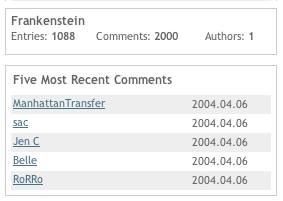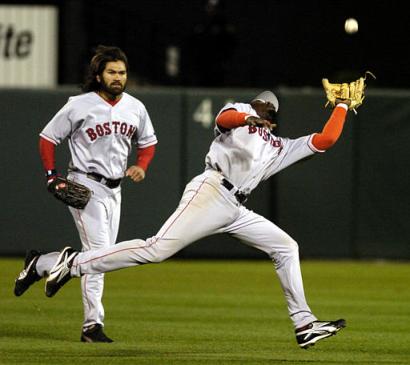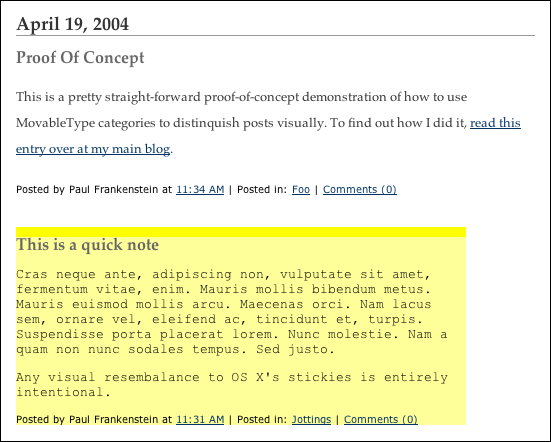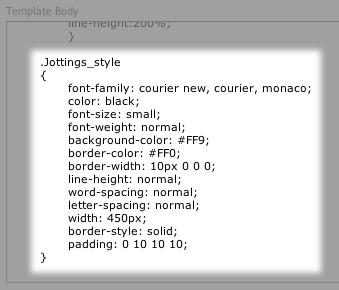Snort chuckle. So that’s where I’ve been going wrong.
April 2004 Archives
Yes, Virginia, it is true that department store dressing room lighting is designed to make you look as unhealthy, pale, anemic, and flabby as possible. In fact, many people have, while getting changed, oddly wondered about the possible existance of albino right whales. One supposes that the theory is that by covering up those acres of pallid whale-flesh, the clothes look, in comparison, to be positively the height of fashion, no matter how they actually look or fit.
The Legendary Mangosteen: better than I remember it? Yup. Worthy of a 2,000-word ode to joy in the Paper of Record? Eh, I don’t think so.
And I am a horrible, horrible, horrible mahjong player. Thought I suppose I could work on learning the rules.
As the other Paul pointed out, it’s time for the May caption contest: pick a quote with the month “May” in it, enter it in the comments, and winner gets their website perma-linked at the top of the rotating link list for the month of May. Any questions?
Since I know that my faithful readers (all three of you) have been waiting with bated breath (not baited breath, unless you’ve been overdosing on pickled herring) with an update from the far side of the world, here are some brief notes:
There are those who would consider being wedged into a middle seat in the second-to-last row of a fully-loaded 747 (seat number 68F, for those of you keeping score at home) for more than twenty hours to be a unmitigated disaster. I, however, am not one of those pessimistic souls; in fact, I have found four distinctly positive things that recommend the experience:
- Being crammed between two total strangers in extraordinarily tight conditions will cause one to reflect upon the nature of global brotherhood (unless, of course, one of one’s neighbors has been getting the ‘extra garlic’ meal option).
- Getting up and walking around seems miraculous.
- It’s close to the bathroom (except, of course, when your neighbor who is occupying the aisle seat is completely sound asleep and there is no way around him that doesn’t risk serious injury).
- And finally, one doesn’t wait so long at the baggage claim to retrieve one’s bags (because, being the second-to-last row in the airplane, it takes 25 minutes to actually get off).
In reality, of course, I spent much of the flight either
- watching Ben Affleck and Uma Thurman soundlessly save the world over and over again in Paycheck (it does seem to be one of those movies that benefits by not having the sound turned on)
- listlessly dozing and slipping in and out of a semi-conscious napping state
- trying to read my book; while it is an excellent book (at least the first 43 pages are excellent), the combination of a full-sized hardback that barely fit on the tray table and the very immediate presence of my seatmates made the physical act of reading, well, difficult at best
- and, of course, wondering when the guy blocking the aisle was going to wake up so I could go take a leak.
The airport, of course, is a science-fiction wonder (gasp! high-speed mass-transit that takes you directly from the airport to the middle of town in 20 minutes!); at least it seems that way after having to navigate the perils of JFK.
Hong Kong itself seems to be, for the most part, pretty much the same as it was when I left it last (hot, humid, great food), with the exception that there is a faint paranoia about germs and cleanliness; a side-effect from the SARS disaster. In other words, Hong Kong is cleaner than I’ve ever seen it; for those readers familiar with the city, you can imagine what a shock that is. The familiar organic aroma of the city has had a slightly medicinal scent added to the mix, as seemingly everything and everyone has been coated with anti-bacterial cream. It is a bit jarring to eat at a restaurant and discover that the packets of hot towels have been replaced with sterile alcohol wipes…
The office that I’m working in is actually located in one of the city’s nightlife hot-spots; it’s been rather interesting wandering around during the day and seeing what has survived the years and what hasn’t. One of my preferred watering holes, a dark hangout called “Yelt’s Inn” (in honor of the former Russian leader) is no longer, apparently replaced by a bright, Spanish-themed bar. Well, I’ll always have my memories.
There’s not much else to report at the moment; I’m putting in long hours at the office, which is kind of interesting given the whole jet lag situation and the fact that I haven’t slept through the night in more than four days. The good news is that the mental haze lifts significantly with each passing day; the bad news, of course, is that said haze will probably hang around until sometime early next week (peanut gallery: “How can you tell?”).
I did bring my digital camera, but I’m still working the logistics of getting the images out of the camera and into the computer here. It might take a while — accessing the net here involves using a dinky Win98 machine with a propensity to crash at inopportune times. But the photographs will come. I just wouldn’t hold my breath.
Just landed in Hong Kong.
Boy are my arms tired.
As I head off into the night (yes, I’m packed now) a parting thought:
There are three kinds of expats:
- Expats who head out on a one-year assignment and come back after three months.
- Expats who head out on a one-year assignment and come back after three years.
- Expats who head out on a one-year assignment and come back after thirty years.
Ta-ta!
Knowing exactly what you’re going to pack.
Though I suppose now (T -4.5 hours and counting) would be a good time to actually start putting it in the suitcase.
Less than 14 hours before I head off to Asia for three months. Let’s go down the checklist:
Packed? No.
Started packing? Nope.
Planning on starting to pack soon? Er, that’d be negatory.
Will I forget something? Probably.
Do I have a big interview this morning that I’m not prepared for? Yes.
Am I blogging and answering email? Yes.
Am I being a bit stupid? Signs point to yes.
An update this afternoon, if I have time.
If you want a postcard from Hong Kong, drop me a line with your real (i.e. snail-mail, a.k.a. postal) address.
Question: What makes a blog a blog?
Answer: The form. More specifically, what distinguishes blogs from other kinds of web media, is that the granular unit of the blog, the quantum unit is the post, not the page.
This post-oriented architecture makes all kinds of things possible. It’s the backbone for the permalink culture, for one thing. For another, it lets me put any given post on this blog exists in at least three places at once: the date archive, the category archive, and the individual archive (and, in the case of recent posts, the front page).
Now all that’s pretty cool. But unfortunately, tools for manipulating posts seem pretty limited. For example, with MT, I can sort my posts by date or category, but that’s about it (one can also sort by author, but that has limited utility for a single-author blog).
Why can’t we have more and better tools for manipulating posts as objects? I have well over a thousand posts on any number of topics in this particular blog, and I imagine that other long-term bloggers have even more than I. We need better tools to deal with these unwieldy databases.
One potential application: picking out sub-narratives from the clutter of a daily weblog. A trivial example would be my running joke about trying to get into the New York Times. This could be done by providing an easy way to see what posts reference each other (maybe you could think of it like a kind of internal trackback) and then mapping them so that the relationship between those six disparate posts would be made clearer. What would be even more useful would be a tool that could cross-reference these sub-narratives: that Another Near Miss post is not only part of my international fugitive sub-narrative, but also relates to this entry from last July, and, in a somewhat more tangential way, this entry from December, and these two photographs.
Now, I know that some of you are saying “but isn’t that what categories are for?” Well, yes and no. Categories are kind of a gross tool, useful for lumping large chunks of data together. If they’re too broad (“Things I Do During The Day”) they’re fairly useless; on the other hand, if they’re too granular (“19th Century Paintings I Saw on the Second Floor of the South Wing of The Metropolitan Museum of Art”), they’re equally useless. Like Goldilocks’ porridge, they need to be just right to be useful. Moreover, sub-narratives often cross categories; the same six posts mentioned above are scattered across three different categories.

Each box above represents a blog post arranged chronologically; the colors represent different categories. This is how most readers experience blogs; a chronological series of disparate posts. There’s no obvious connection between the various posts.
But if the narratives inherent in the various posts could be made explicit, then it might look something more like this:

The thick line indicates a narrative relationship; the thin lines are more tenuous connections.
And if we can manage our blog posts as part of narratives, then we can look at how different narratives threads intersect and interact, and, at least in theory, get a better, fuller concept of the picture that the blogger is trying to paint.
What else can we do if we have tools that treat blog posts as objects? Scott Young pointed out at dinner on Saturday night that there’s not much difference, structurally, between an email and a blog post. They both have a date, title, sender, and a discrete block of text as the main body. So perhaps some the tools that are being developed to help manage email—data mining, for example—can be brought to bear on the blog problem. Maybe someone will develop a blog tool that puts posts in tree-like hierarchies, much like how modern email applications can thread discussions.
Another possibility to explore is per-post access control. At the moment, blog tools, with the exception of LiveJournal, have no real way to control the visibility of each object (well, there is draft/publish, but that hardly counts). LiveJournal offers a binary type of access control: users there can either publish posts publicly or to their “friends” list. As far as I know, there’s no option to only publish to a particular subset of the “friends” list (a “super-friends” list?), but something like that certainly could be useful, particularly in a corporate context.
Perhaps posts could expire after a certain amount of time. This could be useful for time-limited announcements: “Due To Rain, The Company Picnic Has Been Moved To The Cafeteria”. Perhaps time-control and access-control could be combined: for a certain period of time, certain posts are only accessible by certain users; when that period of time has expired, those posts are accessible by all users.
There is no question in anyone’s mind that blogging software has been incredibly innovative and creative over the past few years. The idea that the web could be broken up into smaller chunks than just a page was really revolutionary. I think that now that this post-as-building-block model has been firmly established, the next step is going to be figuring out new ways to manage and play with these building blocks.
During the morning’s first session, Lisa Williams mentioned that one tool that she’d really be interested in using was a way to visually differentiate different kinds of posts; specifically, she wanted a way to visually segregate quick jottings from longer, more reasoned posts.
Well, a little head-scratching later and I came up with this little proof-of-concept.
Here’s the quick how-to (note that the instructions are MT-specific, but the principles involves should be easily applied to other blogging apps):
1. Turn on categories. The categories Foo, Bar, and Jottings are defined in the example.
2. Paste the following code into the main index template:
<div class="<MTEntryCategories><$MTCategoryLabel$>_style</MTEntryCategories>">
In the standard MT template, the line is inserted right after:
<div class="blogbody">
Don’t forget to insert the appropriate closing </div> tag. In this case, it goes after the credit/comments/trackback line.
What this does is apply a style called Categoryname_style to the text of the post. In this case, those would be either Foo_style, Bar_style, or Jottings_style.
However, we haven’t defined those styles yet, so:
3. Define your special styles in the stylesheet:
If you don’t want to apply special formatting to a category, then you can simply not define that style. For example, I left both Foo_style and Bar_style undefined; because those styles are undefined, your browser simply ignores them and uses default formatting (or at least it should).
Note that this is simply a quick demonstration. Actually making those various styles look good would require someone more versed in css than I, as well as, I suspect, somewhat more time. Also, it doesn’t work when posts are assigned multiple categories; I don’t think that this would be a show-stopping bug, though.
My ongoing campaign to get into the New York Times continues apace: the business card cube mentioned in this article was actually made using my business cards.
Unfortunately, the reporter failed to mention that little fact. I guess I still have time to work on that international fugitive thing.
Also, special thanks to Ned Batchelder for actually making the cube and slipping it into the reporter’s handbag.
(for new readers and those confused by the international fugitive joke, some background can be found here, here, here, here, and here)
And boy are my wheels tired. Amy Langfield was moblogging the drive down from Boston, for those of you who like pictures.
More later.
Going to Bloggercon. I’m probably going to be the only one there without a laptop.
Heh.
Well, at least it wasn’t as painful as last year.
From the Northerner:
Pick up the nearest book.
Open it to page 23.
Find the fifth sentence.
Post the text of the sentence in your journal along with these instructions.
Originally, I grabbed Lessig’s The Future of Ideas, since it was sitting on the dining room table:
“Yet so blind are we to the possible value of a commons that we don’t even notice the commons that the Internet is.”
But then I realized that my bookcase was probably just as close, if not closer, than the table.
So I pulled the first book off of each shelf:
“What other German literature on the Jews during the Victorian era could one profitably compare with Nietzsche’s remarks?” — The Gay Science, Friedrich Nietzsche (Walter Kaufmann, trans.)
“His facetious manner had fallen from him like a cloak.” — Our Game, John le Carré
“Precisely so; that is just what we intend.” — Marx & Engels: Basic Writings on Politics and Philosophy Lewis S. Feuer, editor. The specific passage is from “The Manifesto of the Communist Party”.
“As formulated by Peter Gourevitch, the Second Image Reversed proceeds from the premise that ‘instead of being a cause of international politics, domestic structure may be a consequence of it. International systems, too, become causes instead of consequences.’” — China and the World, edited by Samuel S. Kim

Yes, Virginia, that is, with the entirety of his worldly possessions carefully perched atop a converted baby stroller, a homeless man reading the Financial Times.
Between an annoyingly persistant head cold and surfing for pictures of Sophie Ellis-Bextor doing my taxes, not a lot’s going on at the moment.
More new stuff in a couple of days.
Oh, and boy, isn’t that Eternal Mind of the Spotless Sunshine movie something?
We have a winner (actually, this is several days old, but I just hadn’t gotten around to posting this) in the comment contest:

And in other, entirely unrelated news, I seem to be developing an obsession strange fascination with English fembot pop tart Sophie Ellis-Bextor. I was going to write something deep about the differences between English and American pop cultures, but you know what?
- You guys probably know a thousands times more about that subject than I do, and
- It’d really just be an excuse to justify a) the fact that I wasted half-an-hour of my life watching an television interview with her and b) linking to more pictures of Miss Ellis-Bextor.
And since y’all are sophisticated enough to see through something like that, I figured, why bother?
Mel Gibson presents: The Passion of The Easter Bunny?
It may not have been as gruesome as Mel Gibson’s movie, but many parents and children got upset when a church trying to teach about Jesus’ crucifixion performed an Easter show with actors whipping the Easter bunny and breaking eggs.
After last night, I cannot recommend going to the upstairs bar at the Evelyn Lounge on the Upper West Side because it’s impossible to hold a conversation in there. Why? Because the waitresses are so freakin’ hot that coherent thought is pretty much well nigh impossible, that’s why.
So if you’re interested in conversations that have things like, say, complete sentences, then you probably shouldn’t go. If, on the other hand, you’re ok with saying (and hearing) things like “So, work today was… uh… um…” or “And then I wa… uggghhh”, then I guess that it’d be OK.
Zombies in Manhattan, and we’re not talking about rum cocktails: Monster Island, a novel by David Wellington.
Sicilian village plagued by spontaneously combusting electrical devices:
“I’ve seen an air conditioner burst into flames and burn down in 30 seconds. These are not normal events, but I think we�re going to have to start looking for a different kind of help,” said Antonio Pezzino, whose house was first hit.
This reminds me of the Las Vegas keyless carlock failures of a few months ago…
Ok, it’s more like two signs and one piece of graffiti.



Or is that one piece of graffiti and two signs?
So I went ahead and played around with the infamous Match.com physical attraction test. The results were actually kinda shocking; according to the report, I like:
- Pretty girls
- between the ages of 25 and 40
- with good cheekbones
- and red hair
- and green eyes
Green eyes? I never noticed I had a thing for green eyes before! Shit! Crap! Never knew! Fuck! Damn!
So, with my soul already shaken from the stunning revelation that I like green eyes (actually, I’ve never really keyed on eyes; more to the point, I have a friend who keeps complaining that I keep calling her green eyes blue), I went ahead and took their personality test. The results? Well, see for yourself (relevant part conveniently highlighted):

One percent? Johnny Damon Jesus Christ! With this kind of encouragement, it kinda makes me wonder if Match.com is trying to drive sales of these and these.
Another view of those tests: lindsayism.com
The Wolfman has a new poll up. Go vote and help him an imaginary girlfriend.
MSBlast epidemic far larger than believed: 16 million infected? OK people, get with the program. Buy an anti-virus program and use it. And while you’re at it, you might want to check your system for ad- and spy-ware. You might be surprised by what you find.
Here’s Bob’s tale of computer crud.

Jesus Christ, the new centerfielder for the Red Sox, explained after the game that his inability to chase down several fly balls in last night’s game against the Baltimore Orioles was due to a lack of standing water in the outfield.
Hey, you gotta better caption?
Found a white hair… in the stubble on my chin.
Time to start stocking up on the Grecian Formula, methinks…
Minor blog catastrophe averted. Permissions on some kinda important files were set wrong, making doing pretty much anything kinda impossible. But that’s all fixed now.
It’s April and the heat is on in my apartment.
At least it’s not snowing.


